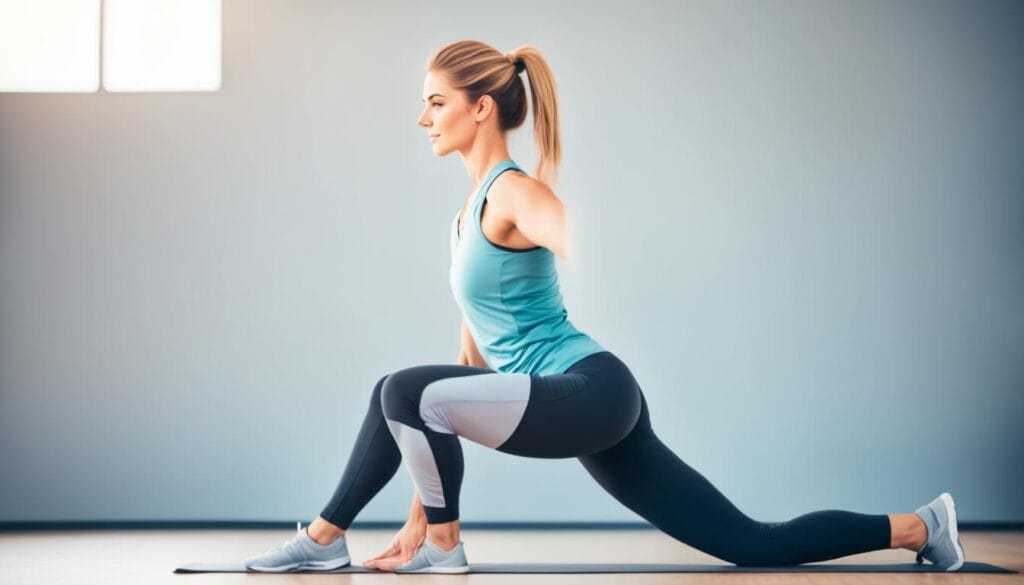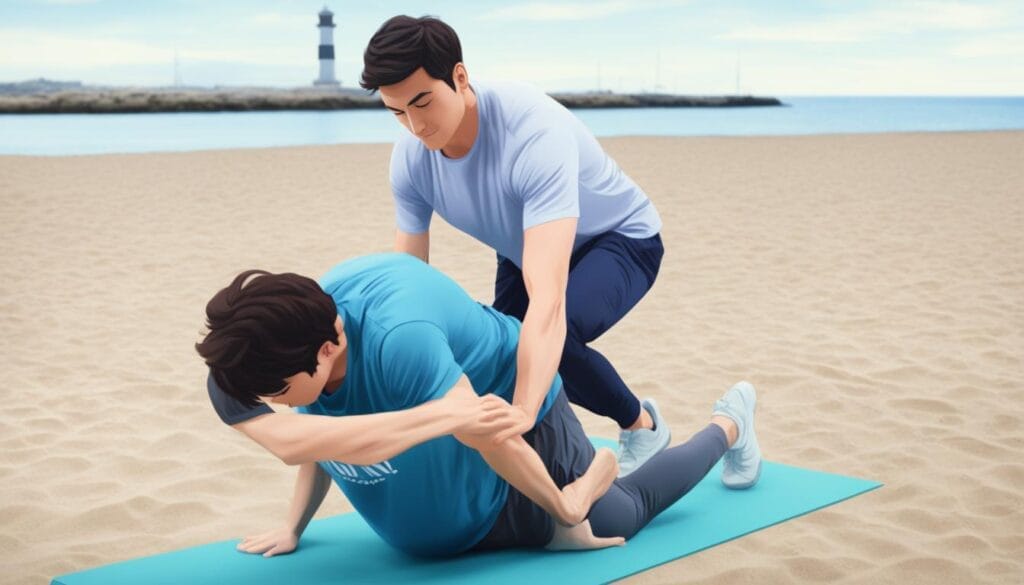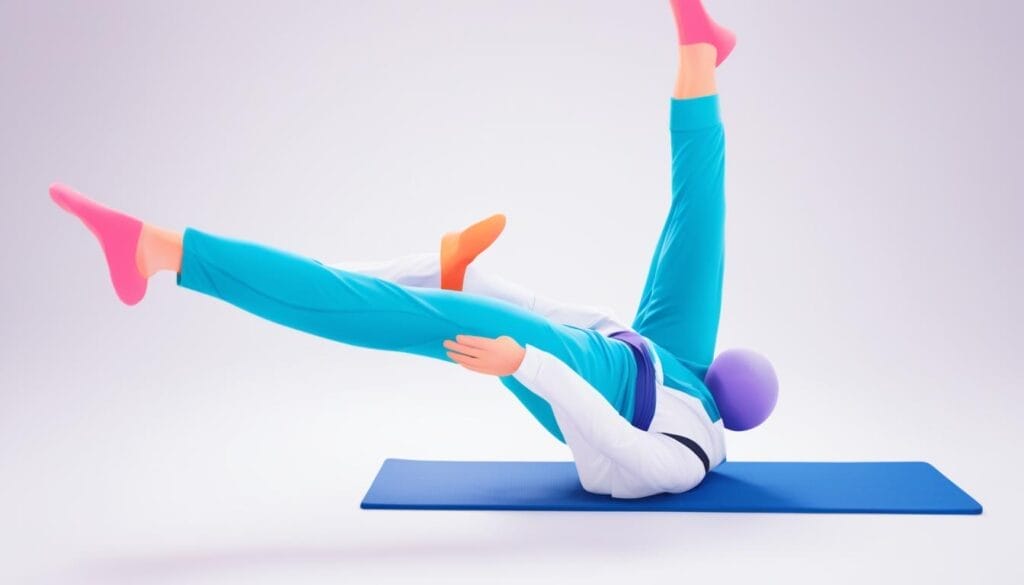I’m big on fitness and staying healthy. So, I know how crucial being flexible is. Whether you’re a pro athlete or just want to feel your best, adding static stretching to your workouts is key.
After tough sessions, I’d often feel my muscles tighten up. This not only affected my game but also made me prone to getting hurt. Then, static stretching came to my rescue. It helps muscles relax and recover faster.
Static stretching means holding a stretch for a bit, letting your muscles ease up. This not only makes you bendier but also boosts blood flow. This helps with recovery and cuts down on how sore you feel later.
This guide is all about a six-week plan to get super flexible through static stretching. You’ll learn all about the different stretches and how to do them right. I’ll share everything you need to know to move better and feel great.
Key Takeaways:
- Static stretching is essential for improving flexibility and aiding in muscle relaxation.
- It promotes better muscle recovery and reduces the risk of post-workout soreness.
- Understanding different stretching techniques and performing them effectively is crucial for optimal results.
- Incorporating performance products can enhance the benefits of your stretching routine.
- Consistency is key, so establish a regular stretching routine to reap long-term benefits.
Understanding Different Stretching Techniques
Improving flexibility and warming up your muscles are key before exercise. Let’s look at dynamic and static stretching. I’ll explain when each is best for your fitness plan.
The Power of Dynamic Stretching
Dynamic stretching gets your body ready by moving in exercise-like ways. It warms up your muscles and boosts blood flow. It’s like a fun warm-up or yoga that readies you for working out.
“Dynamic stretching is like a dance that wakes up your body, increases your heart rate, and mentally prepares you for the workout ahead.”
Doing dynamic stretches, like arm circles, gets your muscles and heart ready. This lowers your chance of getting hurt during exercise.
The Benefits of Static Stretching
Static stretching means holding stretches to relax and lengthen muscles. It cools down your body and helps it recover. This is best after exercising, when you are already warm.
“Static stretching after a workout is like a soothing melody that brings your body to a state of relaxation and recovery.”
Static stretches, like a forward fold, help your muscles relax after working out. They boost flexibility and allow for better movement over time.
A Visual Guide to Different Stretching Techniques
Now, we’ll see pictures of dynamic and static stretching. You’ll see how to do each and when it’s best to use them in your routine:
Dynamic stretching is about moving smoothly to get ready for exercise. Static stretching is holding poses to be more flexible and recover faster.
In the next part, we’ll see how to add both stretch types before and after working out. This will bring the most benefits for your health.
How to Stretch Effectively
Stretching is key before and after workouts. Before, it warms up your body and lowers injury chances. After, it boosts flexibility, cuts injury risks, and helps cool your body down.
Create a routine with various exercises. This way, you target many muscle groups. Here are tips for a great stretch routine:
The Runner's Stretch
The runner’s stretch focuses on hamstrings and calves. Stand with one foot forward in a lunge. Bend your front knee, keeping the other leg straight. Touch your front foot with your hands, feeling the stretch. Change legs after 20-30 seconds.
Hip Flexor Stretch
This stretch helps people who sit a lot. Kneel on one knee with the other foot forward. Keep your back straight. Push your hips forward for a hip stretch. Change sides after 20-30 seconds.
Glute Stretch
It targets buttocks and hips. Sit with legs straight. Cross one leg over the other. Rotate towards the bent knee. After 20-30 seconds, switch sides.
Stretch on both sides and hold for enough time. This boosts flexibility, lowers injury risks, and helps you perform better.
Now, we’ll see how performance products can aid your stretching and fitness journey.
| Stretching Routine | Pre-Workout Stretches | Post-Workout Stretches |
|---|---|---|
| Runner’s Stretch | ✓ | |
| Hip Flexor Stretch | ✓ | |
| Glute Stretch | ✓ |
Support Your Stretching Routine with Top Performance Products
On my fitness journey, I’ve found a great way to boost my flexibility. I use performance products in my stretch routine. These products improve energy, help muscles recover, and make me more focused. This way, my workouts are more effective.
I particularly like BenaGene for its ability to make the body warmer. This makes metabolism increase, which helps burn fat. It’s perfect for both stretching and exercising.
The Biocharged Resistor aids muscle recovery. It boosts blood flow and oxygen to muscles. This leads to faster repair and less soreness after exercise.
For sharp focus and an energy boost, I choose Bulletproof Brain Octane Oil. It offers clean energy for the brain and body. This sharpens my mind during stretching.
Using performance products has really upped my game. They not only help physically but also keep me motivated. They help me achieve my best every day.
Elevate Your Stretching Experience
“Adding performance products to your stretch routine can really make a difference. They support muscle recovery, boost energy, and increase focus. And they make your stretching sessions more effective.”
– Fitness enthusiast
Why not try these performance products to boost your stretching experience? Below is a handy summary of each product’s key features and benefits:
| Performance Product | Main Features | Benefits |
|---|---|---|
| BenaGene | Thermogenic properties | Boosts metabolism, promotes fat burning |
| Biocharged Resistor | Improves blood flow, aids in muscle recovery | Reduces muscle soreness, accelerates recovery time |
| Bulletproof Brain Octane Oil | Provides quick energy source for brain and body | Enhances mental focus, increases cognitive function |

Unlock Your Potential
Using these performance products in your stretch routine can do wonders. They boost your energy, aid muscle recovery, and sharpen focus. Take your fitness to the next level. Unlock your full potential with these great products.
Stretching Done Right: Pre-Workout Stretching
Pre-workout stretching has two main goals: to get you moving well and to improve flexibility. The best way to do this is with dynamic stretching, which is a lot like yoga flows. This type of stretch gets your muscles moving in a way that prepares them for exercise.
When stretching before your workout, make sure your body is in the right position. This helps you use the right muscles and stay safe. Choose stretches that move your joints smoothly and slowly get your body ready for action without pulling on your muscles too hard.
Getting certain muscles ready to work is also important. Doing specific exercises before your main workout can make these muscles do their job better. You might do glute bridges, bird-dogs, or leg swings to switch on muscles like your hamstrings and hip flexors.
Adding pre-workout stretches to your routine is a great way to set yourself up for success. It doesn’t just prevent injury but also makes you perform better. Always do what feels right for your body and your fitness goals.

Intra-Workout Flexibility: Using Eccentrics
Adding eccentric movements to your strength training helps a lot. You can work on both flexibility and muscle strength. This makes your whole workout more effective.
For example, chest flyes and dumbbell bench presses are good for this. They stretch and strengthen muscles in a special way. Your muscles lengthen carefully as you lower the weights.
Doing eccentrics right is about how you move and what weight you use. Make sure you keep good form to prevent injury. As you get stronger, you can add more weight and work harder.
The Benefits of Eccentric Movements for Flexibility
Eccentric movements are great for becoming more flexible. They make your muscles stretch more than usual. This helps you move in a bigger range.
When your muscles lengthen as they contract, you get a better stretch. This stretching helps make your muscles more flexible. It’s like telling your muscles to get ready for more movement.
Eccentric work also evens out muscle tightness. It targets spots that might be too tight. Strengthening and stretching helps these parts work better together. This improves how your body moves.
Integrating Eccentrics Into Your Workout Routine
How you add eccentrics matters. Here’s how to do it right:
- Pick exercises that let you focus on specific muscles with eccentrics.
- Make sure your form is correct to get the best out of eccentrics.
- Begin with light weights and increase slowly to improve strength and flexibility.
- Make eccentric moves a regular part of your workout. It’s good for both flexibility and strength.
Improving flexibility alongside strength is key for success. Eccentrics help with this. They make muscles stronger and more flexible.

Embrace the Power of Eccentric Movements
“Eccentrics have really boosted my workout game. They’ve made me flexible, strong, and steady. I really recommend them to enhance your fitness journey.”
Fitness is all about balance. Remember to mix in flexibility with your strength routine. Eccentrics do this well, improving how your muscles move and work.
Post-Workout or Later: Strategic Stretching
After tough weight sessions, adding static stretches to your cool-down can do amazing things. It can help in muscle recovery and boost flexibility. Doing static stretches after your workout or on rest days is a good idea.
With static stretches, you stretch a muscle and hold it for a while. This helps your muscles relax and get longer. It reduces tightness and improves blood flow, helping you recover quicker.
For the best results, focus on stretching what your body needs. Look at areas that are often tight, like the hip flexors, glutes, and upper back. They might need a bit more stretching.
Targeted Static Stretches:
- Hip Flexor Stretch: Kneel on one knee, with the other leg bent at a 90-degree angle in front of you. Gently lean forward, feeling the stretch in the front of your hip. Hold for 20-30 seconds on each side.
- Glute Stretch: Sit on the ground with one leg crossed over the other. Gently pull your knee towards your chest, feeling the stretch in your glute muscles. Hold for 20-30 seconds on each side.
- Thoracic Spine Stretch: Sit on the ground with your legs extended in front of you. Twist your upper body to the right, placing your left hand on the outside of your right knee for support. Hold for 20-30 seconds, then repeat on the other side.
Try these specific stretches after your workout. They can speed up muscle recovery and make you more flexible. Make sure to hold each stretch long enough. This lets your muscles really get the benefit. Remember, go at your own pace and don’t push too hard.
With these great benefits in mind, let’s next see how special performance products can help your stretching.

Summing Up
Adding regular stretching to your workout has many pluses for your body’s flexibility and mobility. It leads to better health all round. Just use the stretches in this guide and the right gear to help you reach your top performance.
Stretching makes you more limber and cuts down your injury risk while working out. Spend time stretching to make your muscles freer and avoid any twists or pulls.
A steady stretching habit boosts the flow of blood and eases muscle stress. This makes you feel good all over. Improving your flexibility opens up better ways to enjoy daily living, making things less hard and more fun.
FAQ
What is static stretching?
Static stretching means stretching your muscles and holding the position for a while. It’s great to do after you exercise. This helps cool your body down and makes you more flexible.
When should I do pre-workout stretching?
You should stretch before you work out and move a lot. This prepares your body and stops you getting hurt. It also makes you able to move better and easier.
Why should I stretch after a workout?
Stretching after you finish working out makes your body bend easier. This way, you’re less likely to get hurt. It also brings your body’s temperature back down slowly.
What should I include in my stretching routine?
Include stretches like those for runners, your hip flexors, and your glutes. It’s key to do them regularly.
Can performance products enhance my stretching routine?
Yes, using special products can boost how you feel, help your muscles get better quickly, and makes you think clearer.
What should I focus on during pre-workout stretching?
Focus on getting your body in the right shape to move well. Use stretches that flow, like in yoga. This gets you ready better.
How can eccentric movements improve flexibility?
By doing exercises that slowly stretch and strengthen muscles, you get more flexible. This also makes your muscles work better.
Should I perform static stretches before or after a workout?
Do static stretches at the end of your workout or on your days off. This makes your body able to move more easily. Concentrate on areas like your hips, glutes, and the middle of your back.
What are the benefits of incorporating a stretching routine?
A good stretching routine makes you bend and reach better. It helps you avoid getting hurt. This makes you healthier and feel happier too.
Source Links
Share Me:
READY TO UNLEASH
YOUR BEST SELF?
Click “Sign Me Up!” And Start Your Fitness Transformation!





